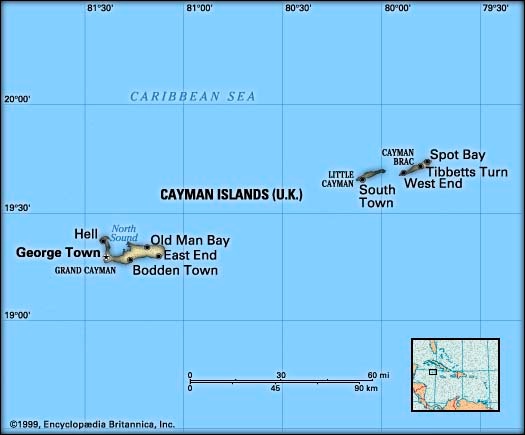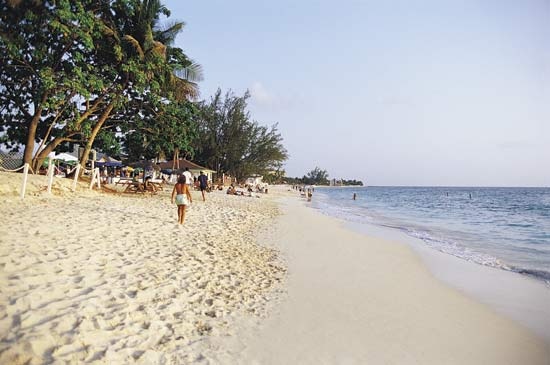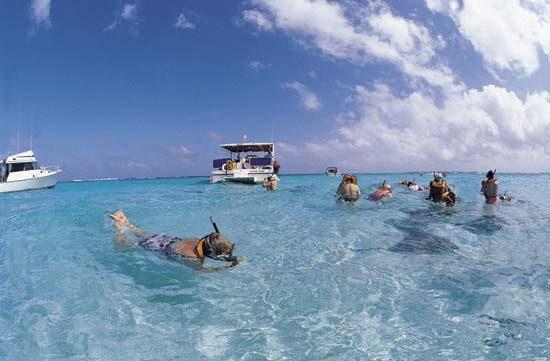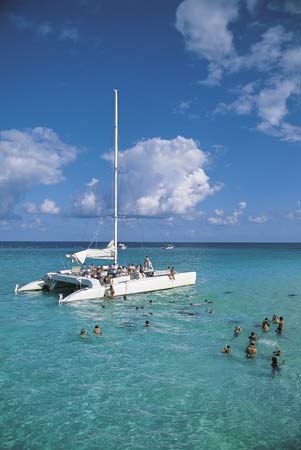Cayman Islands
islands, West Indies
Introduction
Cayman Islands, flag of
 island group and overseas territory of the United Kingdom in the Caribbean Sea, comprising the islands of Grand Cayman, Little Cayman, and Cayman Brac, situated about 180 miles (290 km) northwest of Jamaica. The islands are the outcroppings of a submarine mountain range that extends northeastward from Belize to Cuba. The capital is George Town, on Grand Cayman. Area 100 square miles (259 square km). Pop. (2005 est.) 52,465.
island group and overseas territory of the United Kingdom in the Caribbean Sea, comprising the islands of Grand Cayman, Little Cayman, and Cayman Brac, situated about 180 miles (290 km) northwest of Jamaica. The islands are the outcroppings of a submarine mountain range that extends northeastward from Belize to Cuba. The capital is George Town, on Grand Cayman. Area 100 square miles (259 square km). Pop. (2005 est.) 52,465.

 island group and overseas territory of the United Kingdom in the Caribbean Sea, comprising the islands of Grand Cayman, Little Cayman, and Cayman Brac, situated about 180 miles (290 km) northwest of Jamaica. The islands are the outcroppings of a submarine mountain range that extends northeastward from Belize to Cuba. The capital is George Town, on Grand Cayman. Area 100 square miles (259 square km). Pop. (2005 est.) 52,465.
island group and overseas territory of the United Kingdom in the Caribbean Sea, comprising the islands of Grand Cayman, Little Cayman, and Cayman Brac, situated about 180 miles (290 km) northwest of Jamaica. The islands are the outcroppings of a submarine mountain range that extends northeastward from Belize to Cuba. The capital is George Town, on Grand Cayman. Area 100 square miles (259 square km). Pop. (2005 est.) 52,465.Land (Cayman Islands)
 The islands are generally low-lying, though Cayman Brac has a central bluff that constitutes 90 percent of its landmass. The coasts are ironshore (limestone fringes with numerous marine fossils) interspersed with sandy beaches and enclosed by coral reefs. Grand Cayman is the largest and most populous island, about 22 miles (35 km) long and 8 miles (13 km) across at its widest, with a total area of 76 square miles (197 square km). It has a 36-square-mile (93-square-km) sound that is a breeding ground for much marine life. Cayman Brac, about 89 miles (143 km) northeast of Grand Cayman, is the next largest island; it is about 12 miles (19 km) long, averages about 1 mile (1.6 km) in width, and has the highest elevation of the group, rising to 140 feet (42 metres) above sea level. Its total area is 14 square miles (36 square km). The smallest of the islands, Little Cayman, lies 5 miles (8 km) west of Cayman Brac; it is 10 miles (16 km) long and has a maximum width of 2 miles (3 km) and a total area of 10 square miles (26 square km). There are no rivers.
The islands are generally low-lying, though Cayman Brac has a central bluff that constitutes 90 percent of its landmass. The coasts are ironshore (limestone fringes with numerous marine fossils) interspersed with sandy beaches and enclosed by coral reefs. Grand Cayman is the largest and most populous island, about 22 miles (35 km) long and 8 miles (13 km) across at its widest, with a total area of 76 square miles (197 square km). It has a 36-square-mile (93-square-km) sound that is a breeding ground for much marine life. Cayman Brac, about 89 miles (143 km) northeast of Grand Cayman, is the next largest island; it is about 12 miles (19 km) long, averages about 1 mile (1.6 km) in width, and has the highest elevation of the group, rising to 140 feet (42 metres) above sea level. Its total area is 14 square miles (36 square km). The smallest of the islands, Little Cayman, lies 5 miles (8 km) west of Cayman Brac; it is 10 miles (16 km) long and has a maximum width of 2 miles (3 km) and a total area of 10 square miles (26 square km). There are no rivers.The Caymans are located on the boundary between two tectonic plates, one moving eastward and one westward; minor tremors resulting from the movement of the plates are sometimes recorded. In December 2004 an earthquake of greater than usual magnitude was felt on Grand Cayman, although there were no injuries and no damage was caused to property.
A pleasant tropical climate is one of the territory's main assets, tourism being of primary importance to the economy. Temperatures are moderate throughout the year, averaging about 81 °F (27 °C) annually. The rainy season extends from mid-May through October, and the dry season lasts the balance of the year. The Caymans are cool from November to March, with temperatures ranging 65–75 °F (18–24 °C). Rainfall at George Town averages 60 inches (about 1,500 mm) annually, although the eastern districts of Grand Cayman and the other islands are drier. Hurricanes can occur from June through November.
Mangrove swamps cover nearly one-third of the land area. A variety of commercially useful plants grow on the islands; among them are coconut palms and breadfruit, banana, mango, and citrus fruit trees. There are also thatch palms and some logwood and mahogany trees. The only indigenous mammals are agoutis. There are many reptiles, including green sea turtles, which were noted by Christopher Columbus (Columbus, Christopher) when he visited the islands. Iguanas, other lizards, and frogs are also common, and the islands are rich in birdlife.
People (Cayman Islands)
About one-fifth of Caymanians are of European, mainly British, ancestry; another fifth are blacks, the descendants of African slaves; and two-fifths are of mixed African and European ancestry. The remainder of the residents are of other mixed ancestry or are expatriates. The main spoken language is English, which is heard in a variety of dialects. Spanish is frequently a second language. The main population centre is George Town, where more than half the population lives. Grand Cayman has more than four-fifths of the population. Caymanians are overwhelmingly Christian; the chief religious denominations are United Church in Jamaica and the Cayman Islands (Presbyterian/Congregational), Church of God, Baptist, Anglican, Roman Catholic, and Seventh-day Adventist.
Economy
 The economy depends on banking, tourism, and other services. The Caymans have the highest per capita income in the Caribbean.
The economy depends on banking, tourism, and other services. The Caymans have the highest per capita income in the Caribbean.The physical beauty and superb climate of the islands have made them a haven for tourists. The government invested heavily in promoting tourism, which increased eightfold between the mid-1970s and the early 1990s. Since then tourism has continued to grow steadily, as the islands have developed a good reputation for diving. Most visitors are from the United States. Airports on Grand Cayman and Cayman Brac and a private airstrip on Little Cayman facilitate tourist traffic. Cruise ships call at Grand Cayman, bringing some one million visitors annually on day trips. In addition, hundreds of thousands of stopover tourists (those who stay one or more nights) visit the islands each year.
International finance has become a major component of the economy. The Cayman Islands are renowned as an offshore banking centre, owing to the absence of direct taxes and to liberal banking laws that generally ensure confidential transactions. Hundreds of banks and trust companies, including most of the world's 50 largest banks, are registered in the Caymans, making the islands one of the largest financial centres in the world. Revenue paid by registered businesses contributes considerably to the government budget. There is a shortage of labour, and much of the workforce is made up of immigrants on tightly controlled work permits.
The chief occupations on the Cayman Islands are in clerical and service work and in the construction trades. Agriculture occupies only a small number of Caymanians, and most of the islands' food must be imported. The main crops are citrus fruits and bananas, as well as mangoes, plantains, coconuts, sweet potatoes, yams, and tomatoes. Some livestock is raised, chiefly cattle and poultry. Turtles raised on a government-operated turtle farm provide food, shells, and leather.
Exports are few. The major imports are machinery and transport equipment, other manufactured items, fuels, and foods. The United States is the Caymans' primary trading partner in both imports and exports; other major sources of imports are the Netherlands Antilles and Japan.
Government and society
The constitution, which came into effect in 1972 and was amended in 1994, provides for internal autonomy under a governor (who represents the British monarch), a cabinet, and a Legislative Assembly. The governor is head of state and is responsible for foreign affairs, defense, internal security, the police, and the civil service. The governor also leads the cabinet, which includes three so-called official members and five members elected by the Legislative Assembly from among their own number. The Legislative Assembly consists of 3 members appointed by the governor and 15 elected members.
The Cayman Islands did not have formal political parties for many years; instead, so-called “national teams” made up of nominally independent politicians ran in elections. The Progressive Democratic Party (formed in 1991) was the first political organization to take shape since the 1960s; in 1996 two other groups, the Democratic Alliance and Team Cayman, emerged. Two formal parties, the United Democratic Party and the People's Progressive Movement, were established in 2001 and 2002, respectively.
There are three levels of courts in the Cayman Islands. The Summary Court, including the Youth Court, has civil and criminal jurisdiction. Appeals from the Summary Court go to the Grand Court, which also hears the more serious cases within the criminal, family, common law and civil jurisdictions. Legal actions taken as a result of international offshore banking and financial activities in the Caymans usually are brought before the Grand Court; these involve complex issues and substantial assets. The Court of Appeal hears appeals from the Grand Court; it is composed of a president and at least two judges of appeal. Caymanian magistrates and judges are appointed by the governor on the advice of various other officials, depending on the court on which the justices will serve. The final appellate court is Britain's Judicial Committee of the Privy Council, in London.
The government provides adequate social services, and (because of the chronic labour shortage) the unemployment rate is low. Health care is provided by the Health Services Authority, which operates a hospital on Grand Cayman, a smaller one on Cayman Brac, and a clinic on Little Cayman. The incidence of tropical diseases on the islands is low.
Education is compulsory for children between ages 5 and 16 and is provided free in government primary schools. The government also operates three secondary schools. Institutions of higher education are the International College of the Cayman Islands (1970), the University College of the Cayman Islands (1975; formerly Community College of the Cayman Islands), and the Cayman Islands Law School (1982), all located in George Town.
Cultural life
 Although the island has close historical and political connections to the United Kingdom, the culture and lifestyle of the Cayman Islands is strongly Americanized. There is a daily newspaper, a government-owned radio station, and a monthly newsmagazine. The Cayman Islands National Museum in George Town traces the islands' seafaring history. The Cayman National Cultural Foundation, which depends on a combination of private and government funding, sponsors programs in the arts and maintains the F.J. Harquail Cultural Centre on Grand Cayman, the main venue for local and visiting companies. The National Gallery of the Cayman Islands is primarily an education organization that promotes the visual arts of the islands and sponsors local and international exhibitions of Caymanian art. Theatrical performances and art exhibits are also held by community organizations, and many residents engage in craft work, especially the making of jewelry from black coral. Outdoor recreation centres around the islands' extensive beaches and clear coastal waters.
Although the island has close historical and political connections to the United Kingdom, the culture and lifestyle of the Cayman Islands is strongly Americanized. There is a daily newspaper, a government-owned radio station, and a monthly newsmagazine. The Cayman Islands National Museum in George Town traces the islands' seafaring history. The Cayman National Cultural Foundation, which depends on a combination of private and government funding, sponsors programs in the arts and maintains the F.J. Harquail Cultural Centre on Grand Cayman, the main venue for local and visiting companies. The National Gallery of the Cayman Islands is primarily an education organization that promotes the visual arts of the islands and sponsors local and international exhibitions of Caymanian art. Theatrical performances and art exhibits are also held by community organizations, and many residents engage in craft work, especially the making of jewelry from black coral. Outdoor recreation centres around the islands' extensive beaches and clear coastal waters.History (Cayman Islands)
The Cayman Islands were sighted by Christopher Columbus (Columbus, Christopher) on May 10, 1503, during his last voyage to the West Indies. At first the Spaniards named the islands Las Tortugas because of the many turtles in the surrounding waters, but by 1530 they were known as the Caimanas or Caymanes for the alligators (caimánes) reported to be native there. After the Treaty of Madrid (1670)—which ceded Jamaica and a number of other Caribbean islands, including the Caymans, to Great Britain—the first permanent settlement was established on Grand Cayman. Most of the inhabitants were British mariners, privateers, shipwrecked passengers, and African slaves, as well as land-grant holders from Jamaica. The remoteness of the islands, and integration following the emancipation of slaves in 1835, resulted in a socially homogeneous society.
By the end of the 18th century, uncontrolled fishing eliminated the native turtle population, which had been virtually the only resource of the islands. Cayman Islanders searched increasingly farther away for new turtle grounds, but, as international restrictions grew, turtle fishing was greatly reduced.
For some time the Cayman Islands were a dependency of Jamaica, becoming internally self-governing in July 1959. When Jamaica declared its independence (1962), the Caymans reverted to direct British rule. A new constitution providing for autonomy on most domestic issues was approved in 1972. The Caymans had by then developed offshore banking and tourism, enabling the colony to relinquish aid from Britain. The constitution was revised in 1994; a bill of rights was added and amendments were made to the rules of the Legislative Assembly, among other changes.
In response to concerns over the lack of transparency of the offshore financial sector, the Cayman Islands have concluded treaties with the United States that provide for mutual legal assistance and the exchange of tax information in the investigation of financial crimes. In 1999 the British government published draft legislation confirming that its colonies were to be referred to as United Kingdom Overseas Territories and that all such territories would be obliged to comply with European Union standards on human rights and financial regulation. Under the legislation, citizens of the overseas territories were granted full British citizenship. In the early 21st century a movement began to modernize the constitution, and a government committee submitted a draft to the Legislative Assembly in 2001. Talks stalled in 2004, but by 2007 the process was back on track.
The Cayman Islands were in the path of Hurricane Ivan, the most destructive storm of the 2004 hurricane season. Grand Cayman was badly hit and suffered great economic loss, particularly in the tourist sector; a national disaster was declared. The government instituted a large-scale effort to repair damage to beaches and infrastructure, and the tourist trade was largely restored to full operation within the next several years.
Additional Reading
Pictorial works include Amanda Lumry, Cayman: A Photographic Journey Through the Islands, 2nd ed. (2005); and Paul Humann and Jenny Driver, The Cayman Islands: Island Portrait (2000). Information on the people is available from government publications such as Statistical Abstracts of the Cayman Islands (annual); and Cayman Islands, Annual Reports.A classic source on history remains George S.S. Hirst, Notes on the History of the Cayman Islands, in parts (1909–10, reprinted 5 vol. in 3, 1967). Ulf Hannerz, Caymanian Politics: Structure and Style in a Changing Island Society (1974), is also of interest. Michael Craton, Founded upon the Sea: A History of the Cayman Islands and Their People (2003), is a well-researched and comprehensive work by a noted Caribbean historian. Roger C. Smith, The Maritime Heritage of the Cayman Islands (2000), examines the islands' seafaring traditions. Roy Bodden, The Cayman Islands in Transition: The Politics, History, and Sociology of a Changing Society (2007), presents a multidisciplinary history by a former Caymanian government minister.
- Thomas Fuller
- Thomas Gage
- Thomas Gainsborough
- Thomas, George H
- Thomas George Shaughnessy, 1st Baron Shaughnessy
- Thomas George Shaughnessy Shaughnessy, 1st Baron
- Thomas Germain
- Thomas Gillespie
- Thomas Girtin
- Thomas Godfrey
- Thomas Goff Lupton
- Thomas Gold
- Thomas Goodwin
- Thomas Graham
- Thomas Gray
- Thomas Guy
- Thomas, Gwyn
- Thomas Gwynn Jones
- Thomas Hancock
- Thomas Hardy
- Thomas Harriot
- Thomas Harrison
- Thomas Hart Benton
- Thomas Head Raddall
- Thomas Hearne